#native species of the northeastern united states
Explore tagged Tumblr posts
Text
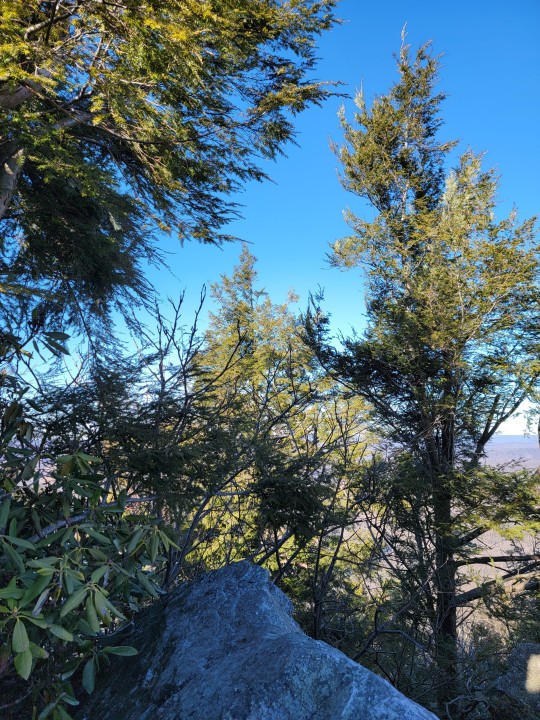
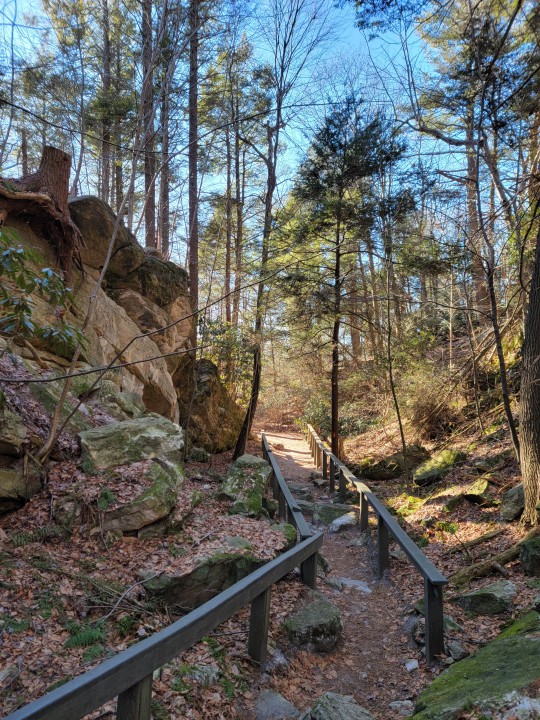
Tsuga canadensis - The Eastern Hemlock
Hello Everyone, today's plant profile should be familiar to you, I talk about Eastern Hemlock frequently on this blog and it's time I made a post that reflects my admiration.
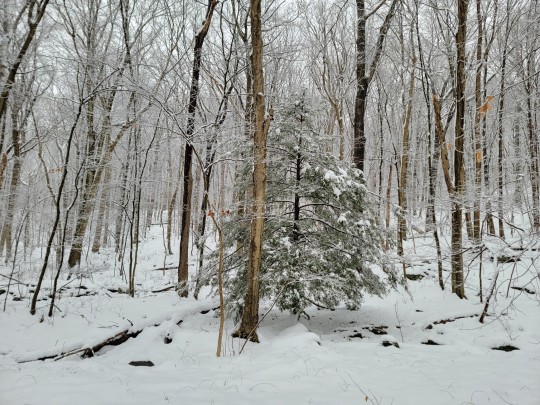
To start let's deconstruct a common misnomer: While the name Hemlock connects back to the plant Poison Hemlock, Eastern Hemlock is not poisonous, English Settlers felt the scent of the foliage resembled that of the notorious herb. The Latin name Tsuga connects back to Japanese name for Hemlock Trees.
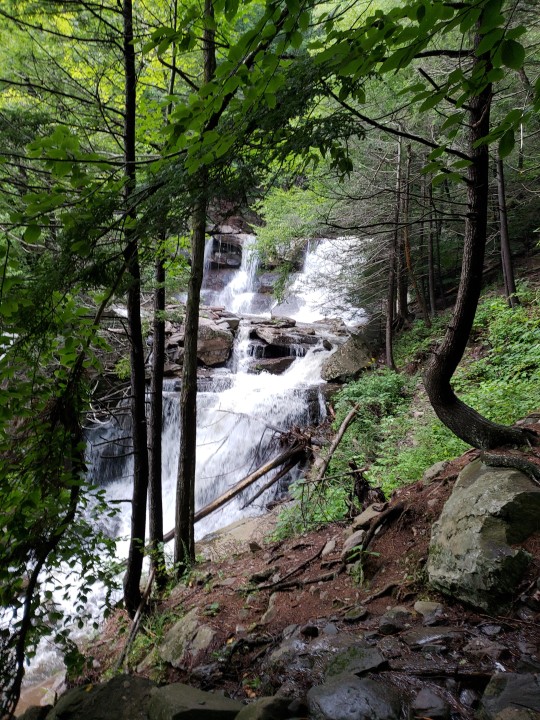
Now the basics: Eastern Hemlock is usually found in mountainous moist (but well drained) regions specifically around coves, canyons, ravines, and streams. The Tsuga family itself are a collection of evergreen conifers with an uncanny ability to grow on extreme slopes. The trunks themselves occasionally protrude from bare rock in bent forms (Image 4 from Kaaterskill falls, NY). Mature trees have pendulous flexible branches to avoid heavy snow loads.
Eastern Hemlocks can be found widespread throughout New England as far North as Nova Scotia and as far west as Minnesota, However as we move southward it becomes increasingly more restricted to the Appalachian mountains eventually ending in Alabama.

In it's native range, identifying Eastern Hemlock from other conifers is fairly easy, the cones (image 5 from inaturalist) are very small and round, while the needles are dark green shiny smooth on one side and a dull light green on the bottom. The needles come out flat upon the branch, almost like it's 2D when you take a cutting. The bark usually has very thick ridges (Image 7) and the tree has a lovely full triangular form (Image 10) at any age. There is only one other Tsuga species within the same range and that's Carolina Hemlock (Tsuga caroliniana), those are generally restricted to the western Carolinas, the needles protrude at any angle from the branch and cones have a type of curled spike. (taxonomy-wise they are not in the same series which is odd)
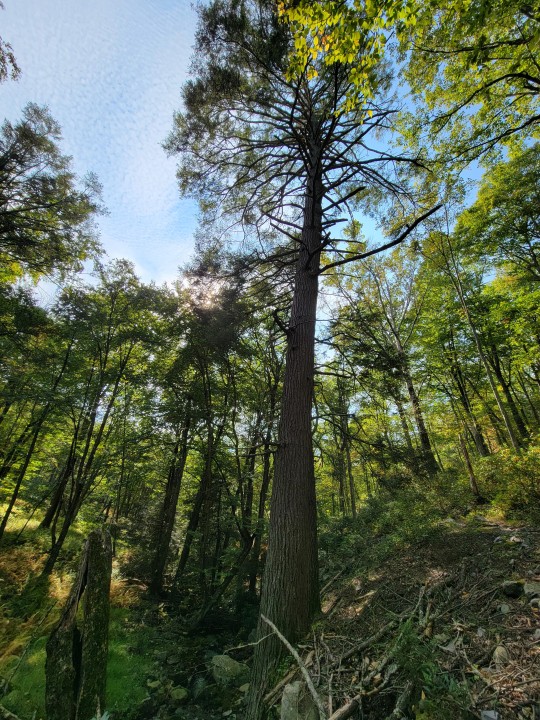
Eastern Hemlock is a long lived species, prior to the introduction of the Wooly Adelgid it was not uncommon to find groves of large trees way over 120+ feet and over 300 years old together. While more northern populations generally tend to be impressively large (Image 6 from Delaware Water Gap), Eastern Hemlock reaches its largest sizes south of Pennsylvania. Specimens in the Smokies still reach a staggering heights of 170' and ages above 500 years (Image 7 Below: Cheoah by Will Blozan). While this isn't as Impressive as its western counterpart Tsuga heterophylla which can reach an insane scale of 270', it is staggering for a tree which faces much hotter temperature conditions.

Just about all of the old growth Hemlocks in Appalachia have disappeared, but there are still old growth forests in Northern New England where the Adelgid hasn't really taken hold. Old growth groves do still exist in treated/cold winter/protected areas and somewhat thrive, I visited quite a few during my time in Pennsylvania. I believe the current species 'champion' is in the Allegheny Plateau.
So what is the Adelgid? It is an introduced aphid-like insect which appears as a wooly white growth on hemlock branches. They seems to kill older trees while younger trees are able to cope with it for a time, unfortunately these sap suckers have eradicated old growth stands throughout the Southern Appalachia. I made a post about my childhood forest loosing all of their giants years back, let me tell you it is a much different environment.

Ecologically speaking, Hemlock serves an incredibly important role in stream health. Growing on literal cliff faces this tree is also wonderful at preventing erosion. The dark evergreen shade of hemlocks not only reduces stream temperatures but retains moisture in the height of summer (image 8). it protects streams from extreme weather in winter too (Image 9). cooler stream temps serve as favorable breeding grounds for a higher diversity of stream species while also creating a refuge in winter cold.
If one wants to find moisture loving salamanders and newts in the east it is very common to find large numbers under the hemlock canopy. Tree falls of hemlock serve as fertile ground for fungi and mosses to cover the trunk. Birch and maple saplings often gain a foothold on the soft remains of Hemlock trees whose wood degrades very fast.
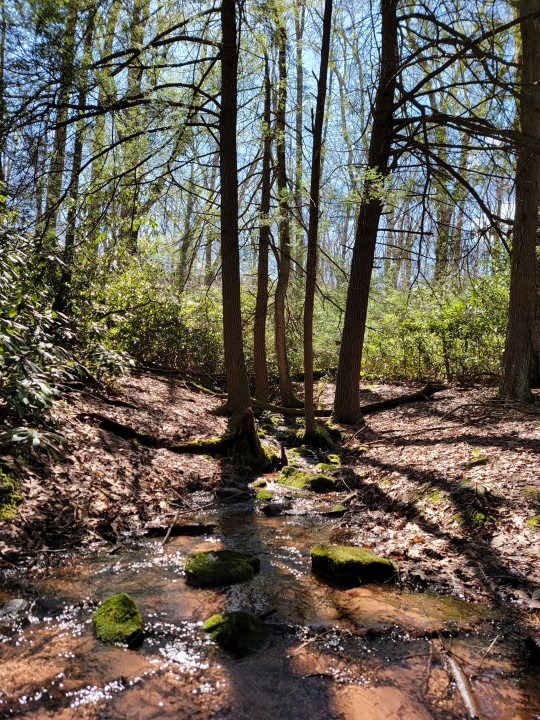
For human usage Eastern Hemlock has an odd history. The bark itself is very rich in tannins, settlers would use it for tanning leather. After the Industrial revolution it was used for railroad ties but today its often ignored or used as paper pulp because of its poor wood quality. As for less commercial functions Hemlock is not really an ideal tree for our consumption, The inner bark can be used as starvation food and the needles are a useful emergency Vitamin C source, However I will warn you that the needles are the least palatable of the edible conifers....
Due to it's poor wood and remote conditions it's not really unusual that so many old growth specimens survived up until the 21st century. Nearly all Eastern forest compositions are influenced by which lumber is most/least valuable.

Last portion - Landscape Value.
Eastern Hemlock in the wild is a beautiful tree in all seasons, naturally the tree will develop into a perfect form on its own, though with Adelgid it has lost popularity as a landscaping tree some people still maintain their trees with a once-every-three-year spraying. There are also many horticultural specimens worth thousands of dollars which have low growing and weeping forms, it is quite a versatile species.
So this has been my piece on the Eastern Hemlock, If you do choose to explore one of the few old growth groves still with us, please clean off your boots and gear. Happy Hunting!
#tsuga canadensis#eastern hemlock#plant profiles#native species of the northeastern united states#conifers
17 notes
·
View notes
Text
Miscellaneous Other Birds

...I'm counting sixteen. No, that one doesn't count, there's still only sixteen.
Following Silverhart's lead, I've left off the names on the initial image so you can guess which is which—some I feel are rather obvious and others rather not. Under the cut I'll put the version with every bird labelled.
Some birds have inspiration from existing birds. A few have very direct inspiration, in that I had a bird field guide with me while drawing and, in the case the bestiary entry didn't spark anything solid, would open it to a random page and use whatever it was as inspiration or reference. I don't remember most of these.
Now, let's buckle in for:
Rapid-Fire Birdbuilding
The Tluftasong
The Tluftasong is a nocturnal bird native to Eastern Europe. It bears strong resemblance to an owl, though it is unrelated. It is roughly seven inches from bill to tailtip, and has sooty grey feathers.
A Tluftasong eats insects and nests in hollows and in the eaves of abandoned buildings. Its pupils are extremely dilated, and are unable to significantly change size. Because of this, Tluftasongs cannot safely open their eyes during daylight and are severely impacted by light pollution.
The Lokfotreag
The Lokfotreag is a bird found only in Scotland. Its body is covered in shaggy brown feathers, save for its head, which is bald, save for a bright red crest of feathers. It is incapable of long-distance flight, and primarily eats corpses.
(My intention with this one was to take "turkey vulture" a bit too literally, but it doesn't look very much like an actual turkey.)
The Hurrashbeg
The Hurrashbeg is a kind of corvid native to Ireland. Its feathers are mainly black, though the tips of its wings and tail and the top of its head are white. It is capable of mimicking sounds, though not as well as a parrot or raven, and is noted for doing so incredibly often.
The Konchilkuk
The Konchilkuk is a kind of woodpecker found in Southeast Asia. It is very easily identified as its body is covered in black-and-orange stripes.
The Wobrahfmet
The Wobrahfmet is a black bird found in all of Europe except for southern Europe. Its head is a slightly lighter shade than the rest of its body. It is not picky in its choice of food, and will dine on plants, insects, and corpses alike, and it makes a loud croaking call that can be heard from an impressive distance.
The Hrongnewit
The Hrongnewit is a small bird of prey—a foot in length at most—found throughout all of Europe except for northern Europe. Its feathers are a sandy brown, with a darker body than head and paler feathers on the undersides of its wings and the tip of its tail. It likes to prey on the chicks of domestic birds, if they are left unattended.
The Klomurgrae
The Klomurgrae is a shorebird native to the Midwestern and Northeastern United States. Its feathers are black with white stripes, and its head is bald. Much of its diet consists of washed-up corpses, though it will also dig in the sand for living invertebrates.
The Zagsmenrok
The Zagsmenrok is a tiny bird, four inches in length. It eats mainly seeds. There are two species of Zagsmenrok—one is found throughout almost all of Europe, and is black with a white beak, and the other is found only in Greece, and is white with a black beak.
(This one was based on a chimney swift! Got lucky with the bird book there—not sure what I'd have done if I'd landed on a duck or something.)
The Hreakgleav
The Hreakgleav is a bird native to Russia. It is covered in shaggy grey feathers, and makes a low croaking call. They are frequently seen nesting in manmade structures. They are omnivorous and will eat anything they can find, from seeds to corpses to small living animals to human garbage.
The Wahrembeag
The Wahrembeag is a songbird found throughout the United States and Canada. It is blue-grey in color, with white feathers along its wings, and it eats mainly insects. It is known for singing particularly loudly just before dawn year-round, and remaining silent the rest of the day when not in its spring mating season.
The Sarbrufeat
The Sarbrufeat is a bird of prey found mainly in Canada and the northern United States. Males of the species have white feathers with grey bands on their legs, while females have mottled grey feathers with white stripes on their chest and legs.
The Keltrumram
The Keltrumram is a waterbird found in the southern United States. It is known locally as the "fool's eagle" because the white plumage on its head causes some to mistake it for a bald eagle. It eats fish.
(I think I remember what this bird is, from the "eagle" week... so I designed something that might plausibly be mistaken for either bird. Assuming I remember right.)
The Grozfarwat
The Grozfarwat is a bird with blue-grey feathers and a broad wingspan. Its head is a brighter shade of blue, and it eats seeds, small fish, and invertebrates. Grozfarwats are known for migrating across the Atlantic Ocean, from Europe to South America.
The Mortelgeng
The Mortelgeng is a bird native to the Midwestern United States and parts of Canada. It is brown in color, with a grey underbelly and bright red spots on its face—for males, they encircle their eyes, and for females they are found only in the outside corners of their eyes. They eat insects and grain, and make a whistling call.
(This is probably my favourite of the birds. The Hurrashbeg and Grozfarwat are both vying for second.)
The Burngraega
The Burngraega is a bird found through Europe, particularly northern Europe. It has pure white feathers and a long neck, and lives near water. Burngraegas mainly eat fish and invertebrates.
The Klethghrom
The Klethghrom is a bird found mainly in Brazil. Its feathers are mainly green, with a dark blue chest, and the undersides of its wings are grey with rose-colored streaks. Its tail is long and dark, with dark blue-and-pink eyespots. It makes a cooing noise, and eats all manner of plant parts.
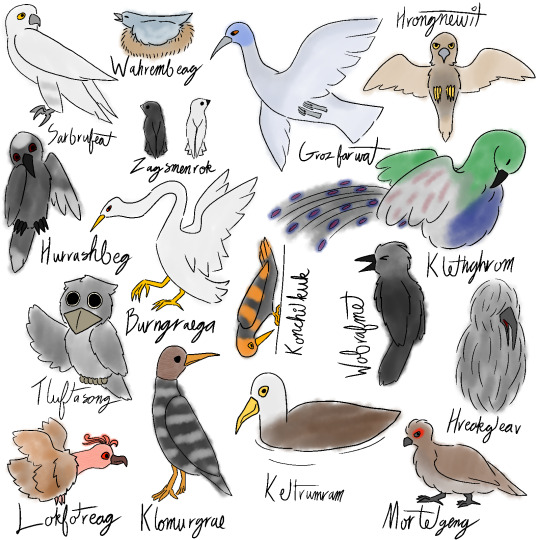
#maniculum miscellaneousbirds#tluftasong#lokfotreag#hurrashbeg#konchilkuk#wobrahfmet#hrongnewit#klomurgrae#zagsmenrok#hreakgleav#wahrembeag#sarbrufeat#keltrumram#grozfarwat#mortelgeng#burngraega#klethghrom#can't believe I typed all those out#bestiary#worldbuilding#fiction writing#strix draws things
8 notes
·
View notes
Note
What’s your beef with the Northern Pike?
I'm so glad you asked.

The northern pike (Esox lucius) is native to the United States (Alaska, Midwest, and Northeastern USA specifically) and Canada, however, it was introduced to many other parts of the US as a sportfish, including parts of Alaska where the northern pike do not occur naturally due to the state's geography. They were also introduced to some places illegally due to some sportsmen trying to establish new populations to angle.

(USGS 2019)
Northern pike breed incredibly quickly and out compete many native fish for resources. They are also predators and eat many native fish as well, causing steep declines in their populations. Northern pike have no real predators, so there is nothing to stop their populations from getting out of control. This is especially a problem in Washington and Alaska where they add additional pressure the already struggling salmonid populations. They are INCREDIBLY hard to remove from the ecosystem once established and are kind of a death sentence for a lot of ecosystems.
If you happen to be fishing in an area with invasive northern pike, do the ecosystem a favor and take that shit out!! Despite what some people might say, they're actually pretty good eating if you fillet them right! There are tons of recipes online if you do get your hands on one. My suggestion is to make fish tacos out of them 😋

TL;DR: Northern pike are very invasive in many parts of the United States and decimate ecosystems.
If anyone is curious about reading further into the topic, here are some resources to look into/the sources I got my information from!
California’s Invaders: Northern Pike (CDFW)
Invasive Pike in Southcentral Alaska (ADFG)
Northern pike (Esox lucius) (WDFW)
Nonindigenous Aquatic Species - Northern Pike (USGS)
Northern Pike remains top invasive species in Columbia River system (The Columbian)
The Pike Problem (Northwest Power and Conservation Council)
Northern pike can wreak havoc on waterways. Some Maine fishermen still welcome them (Maine Public)
#fish#northern pike#thank you for letting me ramble about this#i am very passionate about this subject#wildlife education brain goes crazy
11 notes
·
View notes
Text
Northeast Ancondria, Present-Day: Overview
Library of Circlaria
Blog Posts

Geography
Most of the land of Northeastern Ancondria is a flat grassland about 3000 feet above sea level. Consisting of the plant species Ancondrian Crass, this region is considered the largest source of oxygen on the planet.
There are a few exceptions to the flat plains in the region, however. First is the region of Silba and Beaustrough, which consists of mountains reaching up to 7500 feet. Then there is the region surrounding the Havenlands, known as the Rim Mountains, which reach about 5000 feet. The Havenlands region itself consists of a gentle and gradual downward slope toward the sea, outlining the Southeastern half of an ancient crater. And then the land lining the coast all around the Peninsula is about 20 to 400 feet above sea level.
The climate throughout the flat grassland region is temperate, which is surprising since the region is very close to the equator; however, its high elevation means temperatures here are cooler while the air is less humid. The weather is warm and tropical year-round in the coastal regions, while cool summers and cold, snowy winters dominate the higher land near Silba and the Rim Mountains.
The United Confederation of Ancondria (UCA)
Standing as the larger of the two nations in Northeast Ancondria, the United Confederation of Ancondria, or the UCA, is governed as a direct-representative democracy, meaning that every leadership position in the executive and judicial branches, and every representative in legislature, is elected directly by the voting population.
The UCA is divided into 17 Territories. Each Territory elects 100 Delegates every year, a Governor on every second and seventh year of a given decade, and a Representative to the capital city of Providence on every third and eighth year of a given decade. On every fifth year of a decade, the UCA will elect a Governor-General serving as the Head of National Government, a post subject to a retention vote every tenth year of the decade. Every decision made by leadership is subject to override by popular referendum carried out by the population, who enjoys extensive powers of petition. Every year on a rotating basis, the UCA population will elect 11 Judges to the Supreme Court to each serve one eleven-year term.
The UCA boasts a strong military but strictly adheres to a policy of homeland defense, meaning that they do not deploy abroad unless there is a direct and imminent threat to the Confederation, a policy further enforced by the fact that the Confederation does not hold overseas territory. Most military weapons, planes, and supplies for the UCA Armed Forces are purchased from the neighboring State of Minlon.
As of the year 1475, the UCA stands as one of the most prosperous nations in Ancondria, with its primary industry being lightfire. In fact, the UCA is the world's leading producer of lightfire-made goods. The National Capital, each Territorial Capital, and its immediate lesser towns are connected with roads lined with bike paths. However, bicycles traverse these roadways more frequently than cars; and no national highway system exists because gyroplanes serve as the most common mode of transit. With the lightfire economy comes a wide variety of trades. However, all trades and industries in the UCA pursue one common agenda: environmental cleanliness. The aforementioned roadways over the grasslands are raised above the ground to help protect wildlife and, most importantly, Ancondrian Grass. Gyroplane landing pads are also raised above the ground, while the gyroplanes themselves, while they consume a minimal amount of fuel, are being constantly re-engineered to have a lesser and lesser impact on the environment.
It is also important to note that the population, itself, consists of a great number of differing nationalities. Of these nationalities include Native Ancondrians, Combrian-Ancondrians (or Comans for short), those of close kin to House Maderon, Ostar-Nabukans, Eastern Canticulans, and many folk from the nomadic maritime guilds.
The Sovereign State of Minlon
In contrast to the Ancondrian Confederation, the Sovereign State of Minlon stands as a Consular Republic. Its Head of Government consists of two Consuls presided over by a Head Consul. The Head Consul is the Commander-in-Chief of all domestic and foreign affairs, particularly when it comes to the military. The other two Consuls may give executive orders in the absence of the Head Consul, but the Head Consul can override these orders when there is either a disagreement between the other two Consuls or the Head Consul determines that the executive order agreed upon by the two Consuls is not appropriate. All three Consul positions are elected each for a six-year term but are staggered two years apart from each other, meaning that one Consul position is elected on a rotating basis every two years. Each Consul may be re-elected for an indefinite number of terms, but it is the oldest Consul in age who is deemed the Head Consul.
The Sovereign State of Minlon is divided into five Cantons, with each Canton divided into five Boroughs. Each Borough elects four Delegates, each to serve a four-year term; however, these occur on a yearly rotating basis so that one Delegate position is elected or re-elected each year. The four Delegates from each Borough meet on a regular basis in the Capital City Legislature, which is unicameral.
The Sovereign State of Minlon has one of the most expansive militaries in the world, with a division of ground army, air force, marine, and naval forces for each Canton and each Borough. This military is headed by five Chief-Generals, one for each Canton. Even though the Sovereign State of Minlon has yet to fight in a large-scale war, standing law here imposes conscription upon all young, able-bodied men between the ages of 18 to 23 years.
The de facto most powerful government institution, however, for the Sovereign State of Minlon, is the Judiciary Committee. This Committee is headed by five Arbitrators, consisting of four Arbitrators headed by one Head Arbitrator. Each of these Arbitrators is appointed to their said position by the Head Consul with the only check against such an appointment being a unanimous vote of opposition by all 100 Delegates in Legislature, a move that has never yet happened at the time of the writing of this article. Arbitrators serve a life term until retirement. These Arbitrators are responsible for every decision for every national-level case, dispute, and electoral outcome, as well as for appointing Arbitrators to preside over every Canton and Borough.
According to many critics abroad, the Judiciary Committee of the Sovereign State of Minlon has a notorious reputation for being corrupt. By constitutional principle, the Judiciary Committee is the one responsible for counting the votes and determining the outcome of every election carried out through the State. However, Arbitrators do have a right to "discount illegitimate votes, be it whether they were duplicate votes, votes cast by persons who do not exist, or votes cast by persons who were radically coerced by external influences or threats." The Judiciary Committee is known to use liberally the latter "coercion" reason to exclude certain numbers of votes cast by those opposed to the Five Banks of Minlon, and determine leaders in favor of corporate interests. Critics argue that this means that the Sovereign State of Minlon, though a democracy on paper, is not a true democracy.
There are five large banks in Minlon who own most of the businesses in Minlon as well as fund the State's expansive military. These Five Banks have a large sway in the Legislature, Consulate, and Judiciary Committees, and have been involved in numerous scandals. Of the most notorious was the establishment of the National Debt Collection Association, an organization helping to enforce unfair deals made by the Five Large Banks with businesses abroad. Most notably, numerous branches of the National Debt Collection Association, of the NDCA, consist of armed and well-trained Naval personnel, who go out with gunships into international waters and confront the cargo ships of businesses who owe debts, attacking them to salvage their goods in the form of repayment. The Independent Commonwealth State of Retun, along with many other Circlarian nations, considers this to be piracy, and the NDCA a terrorist organization.
The economy of Minlon is the complete opposite of the UCA in terms of protecting the environment, and consists of two primary industries: junk-flipping and the military. Junk-flipping involves numerous businesses purchasing goods, vessels, and supplies determined by other businesses to be of no value; junk-flippers will pay very little money for these goods and refine them to a higher quality, selling them at a much higher price. In some cases, the goods gained in the first place were not purchased but were seized by force by the NDCA during debt collector raids. Meanwhile, the military industrial complex is one of the largest in the world, with Minlon being a leader in the export of military planes, weapons, and supplies, and being neutral to warring factions, sometimes selling products to both sides of a particular conflict.
One thing to note about the economy of Minlon, however, is its staggering inequality. The City of Minlon is not just economically, but physically stratified, with high-rise skyscrapers over many square miles being connected with walkways, grass fields, parks, pools, baths, and beautiful courtyards on its top level. Those frequenting these areas consist mostly of bankers and leaders, who also own vast houses, estates, and properties out in rural areas throughout the Boroughs and Cantons. However, the nice and modern cityscape of Minlon is all on raised surfaces forty to one-hundred feet above the actual ground, while the properties in rural areas are in secluded areas and fenced in. This whole system is known to the outside world as the Silver Crust, because the remaining population lives either under the raised concrete surfaces of Minlon and the numerous shantytowns of the rural Cantons and Boroughs. Life in these parts is less than ideal, with high costs of living, low paying jobs, little opportunity for education and growth, and limited freedom of movement.
Numerous sectors of the population have pushed for change but were met with stiff oppression, especially at the hands of the Judiciary Committee and their expanded ability to overturn electoral results.
4 notes
·
View notes
Text
Worldbuiltober Day 14: Crown
A meeting of a progressive kanton oligarchy in the Vobanar Confederacy.
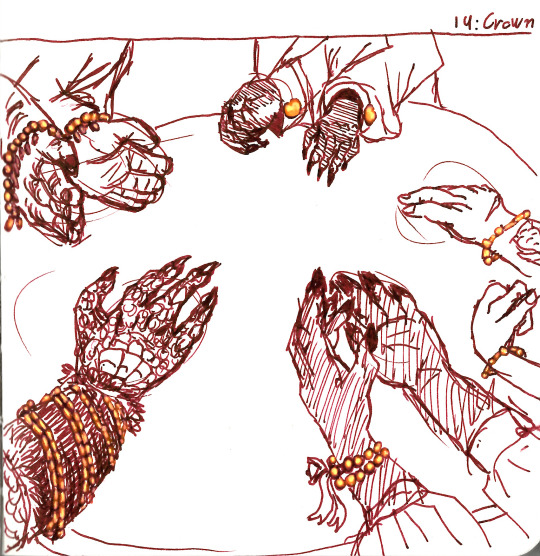
The Confederacy is made up of trading city-states that joined under a confederation along the river Stel. Under pressure of absorption from the Azure Commonwealth, they chose to unite as a confederacy around three-hundred years ago. The Vobanar Confederacy enjoys a subarctic climate with a mild summer. The northeastern mountain range is rich in arcana-sensitive material and metals. Lumber is another important source of materials, including paper, building materials and fuel. Products like radishes, potatoes, wheat, reindeer, goats, sheep, various fur creatures and fish feed and clothe the population. Peat, wool and salt are important resources for the lowland agricultural areas. Furs, amber, salt, ore, lumber, paper, artisan items, knowledge, arcana and cold-weather spices are their strongest exports. The Stel is considered the lifeline of the country. Most major cities lie along it. Each state, "kanton", is goverened by an oligarchy. A push towards stronger democracy has recently shaken multiple kantons. They now include people from most walks of life and species in their power elite through a free voting system. This has given native northern dragonborn and other minorities a bigger chance. Other kantons are goverened by the more traditional groups of urban or land-owning elves, humans and dwarves. The oligarchal elite distinguish themselves by wearing amber around the wrist. The exact style is different per kanton and cultural ethnicity, ranging from cufflinks in Ninestar to whole beaded wraps in the high north.
#art#traditional art#d&d#lanjari#worldbuilding#worldbuiltober#lanjari elf#dragonborn#tiefling#human#dwarf
10 notes
·
View notes
Text
Projects in Brazil’s Caatinga biome combine conservation and climate adaptation

The Serra das Almas reserve in northeastern Brazil has benefited from sustained conservation measures that have turned cropland and pasture back into native Caatinga vegetation and allowed the return of wildlife.
More than 800 animal and plant species are known to occur in the reserve, including the rare three-banded armadillo, a species that, until its sighting here last year, hadn’t been seen in Ceará state since 2008.
The Caatinga Association, which owns and manages the Serra das Almas reserve, has encouraged the creation of more protected areas throughout the biome, providing support for 26 private reserves and three public conservation units, covering a combined 103,600 hectares (256,000 acres).
Maintaining the Caatinga’s vegetation is crucial for securing water supplies for neighboring communities, and the association is supplementing that role in the face of a changing climate by providing water storage solutions to communities.
Continue reading.
#brazil#politics#brazilian politics#environmentalism#caatinga#mod nise da silveira#image description in alt
8 notes
·
View notes
Text
nerd time!! spidersona research!!!
if you see something that is incorrect please let me know!!!!
Yellow Sac Spider/Cheiracanthium
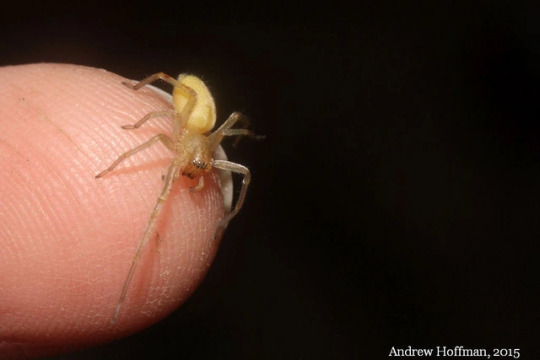
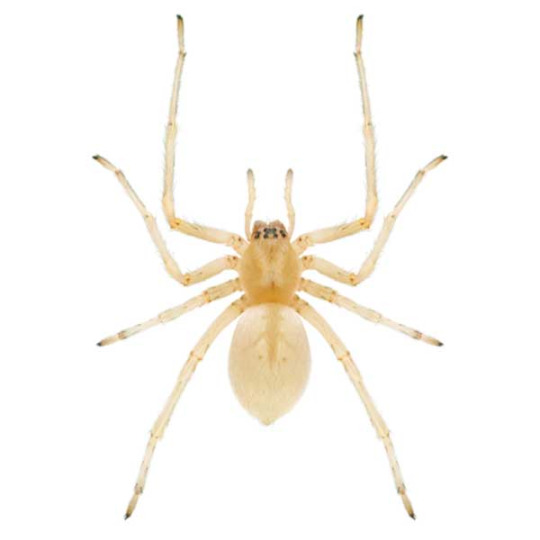

Bite: Creates surface lesion with redness, swelling, burning. Medical attention recommended. Venom is slightly necrotic to humans
Behavior: Bites without reason, hunter (actively chases prey), cannibalistic, most common spider bites. Nocturnal. Do not jump, fast moving, escapes with silk when startled.
Habitat: Gardens, bushes, trees, during cold weather may seek shelter in houses. Northeastern United States, range expanded in recent decades, central Europe.
Size: Females body size range 5-9mm, males 4-8mm. Leg span 2.5cm/1in. Front pair of legs are longest. Males have more slender bodies.
Coloration: Light yellow body, brown jaws, darker legs, vertical dorsal stripes on abdomen. Males are darker. Diet can affect coloration
Body: Scopulae allows them to cling to smooth surfaces like glass, 8 eyes
References: Nebraska University dep of entomology, Wikipedia, WebMD,
Note: I lost some of my references for this entry - take with a grain of salt
Yellow Amycine Jumping Spider
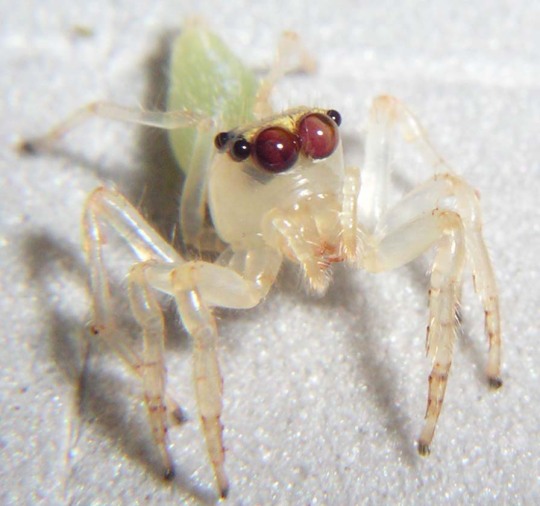


Note: I will be refrenceing Amycine when I can but not much is known about the species
Bite: Unlikely to bite humans, usually runs away. Causes redness, itching, stinging, and swelling. Can be cleaned with soap and water, does not require medical attention
Behavior: Can move rapidly sideways and backwards, pounce on prey. Can jump 20-50 times their body length, use silk dragline when jumping as safety line. Jumping is caused by sudden blood flow change, fully extending legs. Eats insects and other spiders, may drink nectar and plant matter. Hunts during the day.
Habitat: Vegetation, rocky areas, very widespread - no specific habitat. Not found in Greenland
Size: 3.175mm/0.75in, have larger front legs
Coloration: Extremely translucent, eye cones are visible. Joints are dark due to blood flow.
Eyes: Has two eyes on the front, two on each side, and two on the back of their head
References: Wikipedia, US Dept. of Agriculture, Washington State, PestWorld.Org, Michigan State
Striped Lynx Spider



Bite: Little danger to humans, only cause temporary pain and swelling.
Temperament: Daytime ambush predator, nimble. Can shoot venom 20cm/7.9in, only observed in adult females. Strong sense of smell to detect prey. Consuming nectar early in life can deter cannibalism and lengthen lifespan somewhat. Jumps and uses dragline like jumping spiders, is not classified as one.
Habitat: Native coast to coast of southern United States, Mexico, Central America, and the Caribbean. Lives at the top of vegetation in open areas like fields and backyards. Most well seen in Florida and American South.
Size: Females 5.7-6.7mm, males 4-4.5mm and more slender. Fangs are large in proportion to head
Coloration: Pale yellow, can adjust coloration. Males resemble females, but are iridescent that can appear coppery, silvery-green, or purple. Males are usually more red/orange
References: North American Insects & Spiders, University Florida, University Florida, University Florida, iNaturalist
Other spiders I want to look at later: Heliophanus flavipes, Telamonia dimidiata, Crab spiders, Misumena vatia, orchard orbweaver
Note: Always do your own research!!! Doubt the information I gave you!!!
#spiders#spidersona#refrence#Entomology#spider tw#true spiders#Cheiracanthium inclusum#Salticidae#jumping spider#Oxyopes salticus#Striped Lynx Spider#yellow sac spider
4 notes
·
View notes
Text
Why Tullik’s Odyssey?
Tullik is the Iñupiaq word for plover. The species’ annual migration journey starts in the Alaskan Arctic, the traditional homeland of the Iñupiat among other Alaska Native peoples. And odyssey because they course through northern Canada to the northeastern United States, dart across the Atlantic Ocean, and wind up in Argentina. To return—no big deal—it cuts through northern South America, across the Gulf of Mexico, through the middle contiguous U.S., then Canada, and returns to the Arctic tundra.
…
One thing that puts shorebirds more at risk than other types of birds is their dependence on beaches, wetlands, and open areas that a lot of people also like to enjoy. Therefore, human recreational disturbance can be a major threat to shorebird populations. Plus, people tend to visit the beach during the same time of year when these birds are there to eat, refuel, and sometimes nest.
“When they get disturbed by recreationists, that ends up having a cumulative impact on their ability to either breed or to migrate to the breeding grounds,” Gates says. “And so if people take into consideration that putting a dog on a leash will make a bird that's traveled 2,000 miles that day have a little bit of an easier rest for a couple of days before their next part of the journey—having that information in your head and an actionable item—I think is really powerful.”
4 notes
·
View notes
Text
Strangely Pitcher Plants Might Try To Warn Their Prey Not To Enter
Strangely, Pitcher Plants Might Try To Warn Their Prey Not To Enter https://ift.tt/NjRBstz The purpurea in Sarracenia purpurea means purple, and refers to the carnivorous plant’s distinctive reddish-purple venation. But not every Sarracenia purpurea plant is purple. Some are green. This has allowed Martin-Eberhardt and colleagues to ask, why does this species of pitcher plant spend so much effort on making itself purple? Is it to attract prey, or to deter herbivores? Could it even be to attract pollinators? To their surprise, they found that many Sarracenia plants might be trying to deter some visitors. Sarracenia purpurea lives in nutrient-poor soils, its native range being from the northeastern United States, across the Great Lakes region and into Canada as far west as Alberta. It has relatively short and squat cups, compared to the taller more elegant flutes of many Sarracenia. Most of these cups are in shades of red or purple, but some are green. These cups fill with digestive fluid, and the plant kills prey that fall into them and drown. But it’s either not a very good killer or else very selective. Research has found that it captures less than 1% of its prey. Martin-Eberhardt and colleagues wanted to know how much these purple cups helped the plant attract prey. They studied 75 pairs of neighbouring red and green pitcher plants growing naturally in Michigan bogs. They tracked new leaves to see how much prey they captured, how much herbivore damage they took and what specialised insects may have colonised their pitchers. This is a new idea I’ve not come across before. Does the red act as a signal to attract insect helpers to colonise these cups? The results were a bit of a surprise. The red colour did not attract prey, the green plants caught more, over 40% more. Nor did it attract colonisers. It also didn’t help combat herbivory. The red plants were damaged more than the green plants. On every test it seems that red is a worse colour for Sarracenia purpurea than green. Yet the red/green ratio has remained stable for over 60 years. So why hasn’t the plant evolved to be green? A difference Martin-Eberhardt and colleagues noticed is that not only did the red plants catch fewer prey, they also caught fewer pollinators. Green plants were six times more likely to capture Bombus impatiens bumblebees, a known pollinator of the plant. They argue that the two forms of Sarracenia purpurea continue because there isn’t a clear advantage in a specific colour. There are multiple ecological interactions going on simultaneously. Finding a balance between attracting prey, repelling herbivores and protecting pollinators mean that the red pigments in the plant have many different effects at the same time, that a single interaction approach could miss. Martin-Eberhardt, S.A., Weber, M.G., & Gilbert, K.J. 2025. Anthocyanin impacts multiple plant-insect interactions in a carnivorous plant. The American Naturalist. https://doi.org/10.1086/735010 ($) Cross-posted to Bluesky & Mastodon. Cover. Sarracenia purpurea. Image by Rudolphous CC BY-SA 4.0, via Wikimedia Commons The post Strangely, Pitcher Plants Might Try To Warn Their Prey Not To Enter appeared first on Botany One. via Botany One https://botany.one/ February 04, 2025 at 09:00AM
0 notes
Text
So apparently explaining things in detail no one asked to be explained is my thing now.
This is actually my wheelhouse though, I majored in botany. Let's learn about American Chestnut trees!
"I don't know shit about trees, March, what is an American Chestnut? Since when do trees have nationalities?"
The American Chestnut is a type of beech tree. As for why it's called the American Chestnut, it's because this is a chestnut native to the Americas, specifically North America. It's deciduous, a word I love to say [deh-sid-you-uhs], which means it loses its leaves in the fall. These are big fuckers, easily reaching over 40ft/12m, some known to be 100ft/31m, with a max circumference [the around-the-trunk measurement] of 12ft/4m.
"Okay, but there are other trees."
Yes, there are. However, it helps to think of an ecosystem as a Rube Goldberg Machine. If one part breaks, the machine doesn't work. Now, nature has the beautiful ability to adapt much better to a lost part than a machine, but the American Chestnut was a key species of the Northeast/Midwest North American forests. They were an essential part of the canopy.

[IMAGE DESCRIPTION: Chart detailing the levels of a northeastern North American forest. The layers include examples of the plants and bird species found on their respective layers. In order from top to bottom, the layers are: GROUND COVER - There are two variations given of plant species for ground cover, prairie, which is dry grassland, and wetland, which is anything from swampy/brackish areas to floodplains. PLANTS [PRAIRIE]: Gramas, bluesterns, paspalums PLANTS [WETLAND]: Sedges, rushes, cattails BIRDS: Sparrows, shorebirds, waterfowl, wadingbirds UNDERSTORY LOW SHRUBS: Agaritas, yaupons, wax myrtles TALL SHRUBS: Dogwoods, viburnums, hawthorne BIRDS: Mockingbirds, bluebirds, wrens, doves MIDSTORY TREES: Ash, maples, sweetgums, hackleberries BIRDS: Warblers, jays, vireos, chickadees, cardinals, kinglets CANOPY [where the American Chestnut would be] TREES: Junipers, hickories, pines, cedars, maples, oaks, elms, pecans BIRDS: Owls, woodpeckers, vireos, warblers, thrushes, nuthatches, tanagers, creepers ABOVE CANOPY BIRDS: Vultures, hawks, swallows, swifts]
Which means they supported not only everything that lived in the canopy, which included the birds who hunted and foraged above the canopy, but everything above and below as well. You see, everything that grows in the midstory, understory and ground cover levels is filling their niche in the ecosystem, and their niche was below the giants. Shrubs like dappled sunlight, not full light. When the canopy is stripped out, not only is that large source of food and shelter gone, but the plants below are also now weakened until something else fills in that niche in the canopy. So the chestnut blight didn't just take out chestnut trees. It took out whole forests.
"But what was the blight?"
Blight: botany a: a disease or injury of plants marked by the formation of lesions, withering, and death of parts (such as leaves and tubers) b: an organism (such as an insect or a fungus) that causes blight
The Chestnut Blight is caused by a fungus. Cryphonectria parasitica.
"Chestnut Blight: Cryphonectria parasitica Chestnut blight is caused by the fungus Cryphonectria parasitica and infects American chestnut trees (Castanea dentata) throughout the United States and Canada. Once a major tree species, American chestnut trees filled Eastern and Midwestern forests. The fungus arrived from Asia with the import of Japanese chestnut trees in the late 19th century. By 1913, the disease had wiped out enough trees to warrant investigation by the USDA"

[IMAGE DESCRIPTION: A close-up photograph of the bark of a juvenile American Chestnut tree infected with Chestnut Blight. The fungus appears as a rash of small, irregularly formed oblong bumps on the bark. The fungus is a burnt-orange color, in contrast to the medium-brown of the tree bark.]
Now, what the person in that comment is likely talking about is the attempts to stop the blight. The blight struck in the late 1800s. And yes, when forestry experts realized what was happening, they did start cutting down trees. But it wasn't for the reasons this person is stating. When a fungus or disease gets into an ecosystem, the only way to save it, especially in this time period, was to absolutely annihilate the infected parts. These trees were chopped down and burned to stop the infection from spreading. Unfortunately, it did not work.
"Chestnut blight (Cryphonectria parasitica) has probably had the most pervasive influence on forest structure and composition in the southern Appalachians of any disease or insect. Prior to the introduction of this disease, the American chestnut (Castanea dentata) was the tallest and most dominant hardwood species in the eastern United States (Fig. 2). It grew in vast stands from Maine to Florida, with the largest trees occurring in the southern Appalachians (Schlarbaum et al. 1997). After the introduction of the fungus, which probably arrived on nursery stock from Asia around 1900, native chestnut trees, which had no resistance, quickly succumbed. The fungus enters a host through cracks or wounds in the bark and multiplies rapidly. It produces sunken cankers which expand and girdle the stem, killing everything above the canker, usually in one growing season (Fig. 1). Fungus spores can be transported by wind or on the feet of migrating birds and insects. The disease can spread rapidly — about 24 miles per year (Schlarbaum et al. 1997). By 1929, nearly all counties in the southern Appalachians were infested; by about 1940, most of the standing chestnut trees were dead (SAMAB 1996)."
So the American Chestnut is very much not extinct. The blight does not effect the rootstock. [Link to an overview of what rootstock means in this context] It effects the juveniles. We need to find a way to get the trees resistant to the fungus, which is where genetic engineering comes in.
And we have failed many, many times. But...for science, that's not a sign to give up. Usually when your experiment fails, it helps you get closer to an answer that will work. And many people have been working since the blight started over a hundred years ago to keep the American Chestnut from going extinct. And it might take another hundred years to get
The blight was not anyone's fault. At the time, there was so much unknown regarding invasive species and ecosystems. You ever wondered why there are so many regulations about what plants you can and cannot bring in to another country? [gestures up at entire post] This would be an example why, and why you need to follow those rules. It's not just the plant you're carrying. You are essentially bringing foreign diseases into an unvaccinated population.
This has been "American Chestnut Trees" with March.
The most "???????" thing I found in r/collapse though was a thread talking about the "extinction" of the American Chestnut tree...the whole thing, but in particular this fucking comment

the implication that right after the blight started, "settlers" suddenly got the idea of cutting down all the trees. Does this person think a tree has to be already dead to be cut down for wood?
"there was no breeding project or attempt at all at saving them" shut up. just shut up. i beg
"University extensions are encouraging people to cut down healthy ash trees so they can sell the timber" ..."they?" The university extensions?
So for context, the American chestnut is NOT extinct, it has been the subject of intensive breeding programs with a broad and robust genetic base for decades, genetic engineering has been used to create trees with blight resistance that are now being planted and the work is continuing, I have had the privilege of speaking with some of the people that have devoted their entire lives to saving this tree, and let me FUCKING tell you, the eighty-year-old gentleman walking with a cane did not hobble painstakingly up a mountain to the chestnut grove for some dumbass to say "boohoo so sad that there were no breeding programs for american chestnut tree"
I cannot even describe how humbling it was to hear the old folks speak about the decades they worked to save the American Chestnut tree, long before the technology now being used to create blight resistant trees even EXISTED. It is a quest that will take multiple human lifetimes to complete, the people that began it will never see the trees grow old, but they made it their life's mission anyway.
I'm just...unable to understand why someone would say something like that. How could someone be so attached to their sad, dismal fantasy of apocalypse that they either fail to learn about, or outright lie about, a much more beautiful truth????

LOOK AT HER, YOU BITCH.
1K notes
·
View notes
Text
4 Varieties of Privet Invasive Species
Privet is a shrub brought to North America by European settlers around the mid-1800s, who planted them as ornamental plants. While many subspecies of privets exist, the 4 main ones found in Pennsylvania are Chinese privet, European privet, Japanese privet, and border privet. Over time, plant health care experts have identified these as privet invasive species. The damage caused by these plants includes crowding out native plants and reducing biodiversity.

Types of Privet Invasive Species
These 4 specific varieties of privet mentioned above have all been added to the Pennsylvania Department of Agriculture’s Noxious Weeds list. As such, these privet invasive species will no longer be available for purchase in nurseries and other flower shops, and homeowners are encouraged to replace any of these species on their properties with different plants. Here is what you need to know about these 4 species.
Chinese Privet
Chinese privet is native to China, Taiwan, and Vietnam. The fast-growing shrub can grow up to 15 feet in height, forming dense thickets. The leaves are around 1-3 inches long and glossy dark green, and the leaves appear early in spring before the white flowers appear in mid-to-late summer (June through August). The fruits are black drupes with hard shells containing one seed each. These ripen in the fall and persist on the plant throughout winter until removed by birds or other animals.
European Privet
European privet is native to central and southern Europe. This species, with glossy dark green leaves, can grow anywhere from 12-15 feet tall. In the spring, European privet produces white flowers, and in the fall, black fruits poisonous to humans. In addition, the flowers have a strong, pungent fragrance that many people find unpleasant.
Japanese Privet
Japanese privet is native to central and southern Japan. This species is an evergreen shrub, a small tree that can grow anywhere from 7-16 feet tall with a spread of 10-15 feet. The leaves are broad and glossy dark green above, with a paler glaucous to yellow-green color below, and have a thick, leathery texture. White flowers appear in the early summer followed by purple-black fruits in early winter.
Border Privet
The border privet is native to Japan, Korea, and northeastern China. Border privet is a deciduous shrub that grows to 9-10 feet tall with glossy leaves that can be 1/2 to 2 inches long. The white flowers appear in early summer, and black fruits follow in late summer or fall.
What Makes Privets an Invasive Species?
These species of privet are found throughout landscapes in Pennsylvania, but because the plant is not native to this region, privets have no natural predators or competitors. Due to this lack of natural predators, privets can more easily outcompete native vegetation for sunlight, nutrients, and water.
Privets reproduce sexually (by seeds) and asexually (by sprouting new shoots from their roots). This allows them to spread quickly through disturbed soil created by fires, forest clearings, erosion, or abandoned agricultural land.
Finally, privet trees proliferate quickly, often reaching maturity within five years after germination. Many other plants take 10-20 years before reaching maturity.
Damage Caused by Privets
The damage caused by privets is widespread in the United States. These species cause damage to landscapes and native ecosystems, preventing native plants from growing and reducing populations of pollinators such as butterflies and honeybees.
Treating & Managing Privets
Treating and managing privets is best done by professionals with specialized equipment.
Individual, small privets can be pulled by hand and can be done year-round. An important note is that roots must be removed entirely from the ground to prevent resprouting. Larger stems require specialized equipment that a plant health care expert can access.
Mowing can be an effective treatment and control method, but an herbicide application to the cut surfaces must follow. In addition, the time after cutting to apply herbicide changes based on whether the herbicide is oil- or water-based.
Foliar herbicide treatments are also highly effective for treating landscapes with privets, especially with low to moderate plant densities. These treatments are ideal during mid-May to early fall.
Basal bark treatments are effective against privets and can be applied throughout the year.
As always, these control and treatment options require specialized, extensive knowledge of plant health care techniques. So, call a plant health care expert if you need help with privets in your landscape.
Contact Burkholder PHC for Invasive Plant Treatment & Removal
These 4 varieties of privets are invasive species, and can overtake landscapes, with their dense thickets preventing native plant species from growing. To keep your landscape healthy and able to thrive, we recommend a professional evaluation to help remove and control any adverse effects. Our evaluation is free, and the proper treatments can help improve the health of your landscape. Contact Burkholder PHC today for a free consultation.
Blog is originally published at: https://www.burkholderphc.com/privet-invasive-species/
It is republished with the permission from the author.
0 notes
Text

Plant Growing Post: Lupinus perennis sub. perennis
Hello everyone, with February coming around it's a great time to start thinking of growing. If you're like me and are into experimentation and love threatened species, consider growing the Northeast's only native lupine: the Sundial/Wild Lupine
Why is it important to grow this species? 1. It is the larval host plant for the Federally listed Karner Blue butterfly whose range once spread from parts of Wisconsin to Maine but is now restricted to very localized areas of Wisconsin, Michigan, and New York State. (Species survival is complicated due to restricted mobility and climate change). 2. The plant itself has also become incredibly rare in NJ, New York, and Pennsylvania due to land use changes and lack of natural fire regimes.

Why am I doing this? To hopefully teach people closer to existing Karner Blue (image above from inaturalist) populations with successful grow methods. Reddit guides were so snarky and rude I wanted to make a nicer guide. Also, personally, in NJ there are only 4 known populations of this lupine, historic populations were once more plentiful, and the Karner Blue may have existed here as well.
The natural habitat of Sundial/Wild Lupine is Oak-Savannah, these aren't necessarily rare but they're more common in acidic mountain tops and sandy barrens. The key growth factor needed for our native lupine is open canopy with enough sun to remain successful. I'm letting you know the native habitat to key you in on its tougher-to-grow features: infertile soils and a DEEP taproot.


Okay let's begin: I'm always a proponent of collecting wild local seed from native populations, unfortunately, local populations were on private land so I settled for a trusted seller who does genetic testing: Prairiemoon (ignore the Carex) but there are other local sellers in New England. Genetic testing is important because some nurseries will sell you hybrids which are not helpful to the Karner Blue and potentially invasive. I have grown wild lupine before but my dogs killed them so this was a new attempt.
Wild collected seeds require moist cold stratification for 60-90 days, though some will germinate with no stratification and my most successful germination came from scarification and quick stratification (the sellers germination process essentially). For this you want to place the seeds in between a sheet of sand paper and rub until the outer shell is nicked enough to allow water to penetrate.
Here is where inoculation comes in: members of fabaceae have a relationship with a bacteria which allows the roots to capture nitrogen from the air. Some places sell the specific inoculation but the bacteria is present in most soils. This is rather taboo on my end but for species like this I usually take some soil near an existing legumous species (where this bacteria is basically guranteed to be present) mix it with water and take a light amount of this water where I'll briefly soak the seeds in a shallow dish before stratification. This is optional but I've done this for years and have noticed better growth in my Fabaceae than those I haven't preformed this on. If you include too much silt in your liquid you will introduce harmful bacteria as well. Also, it's possible I'm not really doing much with this but better growers than I will correct me.
Finally cold stratification: place the seeds flat in a moist (not soaking wet) paper towel then place in a bag in the fridge for a minimum of 10 days. Once the seeds swell in size they're ready to plant (Day 0). Don't be like me and do this wayyyyyy too early by mistake.


I started my seedlings in a seed starting tray with peat to ensure germination, by [Day 5] they should begin to sprout. On [Day 9] the first leaves form and the taproot develops, you NEED to move them to a deeper pot quickly or else the taproot will be damaged. I got cloth deep root (10") pots and filled them with an infertile mixture (remember they derive nitrogen from the atmosphere) of peat and sand... you don't have to use peat, you can mix soil I just had a lot of peat left over. If you transfer everything correctly and not over water, the taproot will happily continue to develop as true leaves begin to form [Day 16 and 18 below]


I personally sit my plants on a south facing window and then give an additional 3 hours of LED lights after sunset. I've given them around 6-8 hours of direct light but I'm probably spoiling these plants because I'm growing them with my orchids. If you do this 10 days before last frost, you can leave it outside. I currently have 12 Lupines: starting at 90% seed viability, 18 seedlings (only tranferred 14), only two seedlings died after the first 15 days
Continued development: [Day 26] image below left- second leafing. [Day 29 Image 1] continued growth. Last image [Day 38] with third leafing. When it's time to plant out I recommend making sure you dig a hole as deep as the taproot and plant in full sun in dry soil.
I do not believe these make flower in the first year, like many lupines they go dormant in summer, this batch's survival is questionable because it's February. I'll keep everyone updated!


#gardening#lupinus perennis#native plants of the northeastern united states#sundial lupine#wild lupine#grow guide#please look into the karner blue there is another blogger on here with an excellent post about them#propagating native species#seed starting
2 notes
·
View notes
Text
Are 'Giant, Flying' Joro Spiders Really Taking Over The U.S.?
The Black-and-Yellow Arachnids Are Making Headlines Again, But Scientists Say Not To Be Alarmed.
— By Jason Bittel | June 06, 2024

A Female Joro Spider tends her web in Oconee County, Georgia, in 2021. Photograph By David Coyle, Clemson University
Joro spiders are in the news again, and judging by the headlines, everyone is doomed.
“Giant venomous flying spiders… heading to New York area,” says CBS News. “East Coast braces for invasion of palm-sized venomous spiders capable of flying,” echoes Fox Weather. And The Guardian calls the arachnids “gag-inducing."
Of course, the scientists who study these animals, which are native to Asia, say such descriptions are misleading at best.
Floyd Shockley, an entomologist and collections manager at the Smithsonian National Museum of Natural History in Washington, D.C., says he’s “mortified” by some of the sensationalist headlines. “There’s no evidence that they’ve made it to New York.”
While it’s true that joro spiders arrived in Georgia in 2014 by unknown means and can survive in the United States, their colonization of the continent isn't exactly imminent. So far, the spiders have been seen in Georgia, the Carolinas, Tennessee, and Oklahoma, with a few tiny satellite populations in places such as Maryland.
For instance, a recent Gothamist article describes the spiders as having “a body about four inches long and legs that span six to eight inches—about the size of a human hand.”
“That is completely ridiculous,” says Shockley. “You’d have to stretch this thing out like a medieval torture device to get [its legs] even four inches, let alone six inches.”
What’s more, at this time of the year, every joro spider in the U.S. is no larger than a grain of rice. Adults die each winter, with eggs hatching in the spring and starting the cycle anew.
With so much misinformation afoot, let’s take a look at some of the other claims circulating online.

Joro Spiders are known to weave exceptional large webs. In this case, a Joro Spider web was strong enough to support a perching cardinal. Photograph By Arty Schronce
Can Joro Spiders Fly?
“The way those headlines are written, it makes it sound like they’re the monkeys in the Wizard of Oz,” says David Coyle an assistant professor and invasive species expert at Clemson University.
In truth, none of the large adult joro often pictured in news stories are capable of flight. However, as spiderlings, joro and many other spiders can take to the skies in a common dispersal process called ballooning.
“Right after they hatch, the little hatchlings may be the size of a sesame seed,” says Coyle. “Some of them will get up high and they’ll raise their abdomen. They’ll put a few strands of silk out, and some of them will get carried away by the wind.”
“I hate to tell people, but every spring, there’s probably thousands of little spiders ballooning over your head, and people have no idea it’s happening.”
As for their "flying" to new states, Shockley says "they have expanded their range, but it's not surprising for an introduced species in 10 years to have moved, you know, a state."
He adds "we still don't really know anything about how they would [survive] northeastern winters, because obviously they're not there yet."

This Spider Web is Strong Enough For A Bird To Sit On, A Scientific First! The newly recorded behavior could mean the Jorō Spider, An Invasive Species, can provide a small but positive benefit to other wildlife. A massive Joro spider web glistens in backlight sunshine in a Georgia backyard. Photograph By Bluiz60, Alamy Stock Photo
Are Joro Spiders Venomous?
This is actually a bit of a trick question, since "spiders are predators and use venom to capture their prey,” says Shockley.
This means that nearly every spider on Earth is venomous, save for two small spider families that have lost the ability to produce venom.
The real question is whether an animal is venomous in a way that could harm people. For U.S. spiders, that is an incredibly small category that includes black widows and brown recluses—not joros, whose venom is non-toxic to people, he says.
In fact, the few reports of joros biting people suggest it’s like something between the itchy irritation of a mosquito bite and the pain of a bee sting.

These Non-Native Arachnids (pictured, a female) prefer to build their yellow-tinted webs high off the ground. Photograph By Malcom Fairman, Alamy
Are Joro Spiders Aggressive?
Despite being relatively large and brightly colored, the joro spider is kind of a pushover.
“Based on my research, they’re really shy,” says Andy Davis, a research scientist at the University of Georgia. “If you leave them alone, they’ll leave you alone, and you can both go about your business.”
In a 2023 study published in the journal Arthropoda, Davis found that when threatened with a puff of air, native spiders froze for about 96 seconds before resuming their spiderly duties.
Joro spiders, on the other hand, didn’t move again for more than an hour, making them the most timid arachnids on record. (Read more: “Turns out that huge spider invading the U.S. is incredibly ... shy?”)
“I have held joro spiders dozens of times,” adds Coyle, who has never been bitten. “My kids have held them. They’re typically very docile.”
"They’re just big and scary-looking to a lot of people, but that doesn’t necessarily mean they’re mean or have malevolent or malicious intent.”
The Truth About Joro Spiders
However unwelcome joro spiders are in the U.S., some experts say it’s time to get used to their new neighbors.
“This is a tough sell,” says Davis, “but maybe, instead of trying to do away with them, people should just maybe sort of learn to live with them. Because their spread is exponential at this point. Like, there’s millions upon millions of them.”
As far as their impact to the environment, it's likely a mixed bag. Joros eat other invasive species, including brown marmorated stink bugs and spotted lanternflies. However, there's also evidence they're outcompeting native spider species.
Even so, Coyle doesn’t see much reason to kill them on sight.
“If it sparks joy, smash them,” he says. “Are you going to do any measurable impact whatsoever to the population? No, you’re not.”
youtube
#Youtube#Giant | Flying | Joro Spiders 🕷️🕷️🕷️#The Black-and-Yellow Arachnids 🕷️🕷️🕷️#Scientists#Spiders 🕷️🕷️🕷️ | Invasive Species#Human-Wildlife Conflict#Social Media | Wildlife#Animals#The National Geographic
0 notes
Text
Miscanthus sinensis Chinese Silver Grass

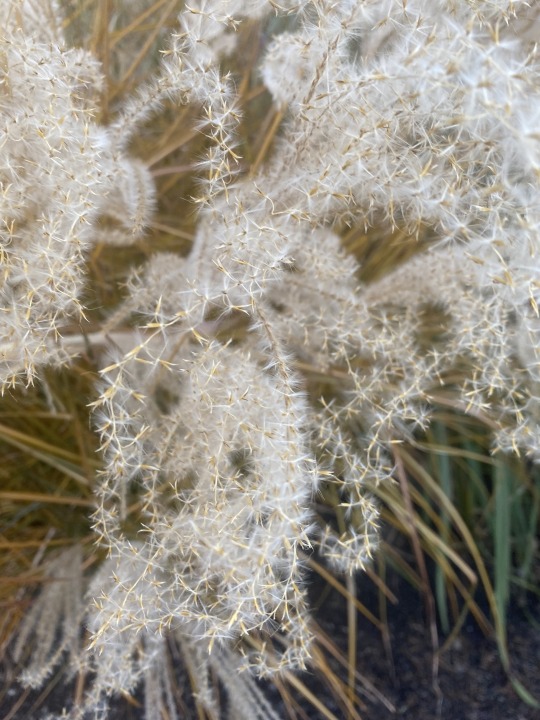
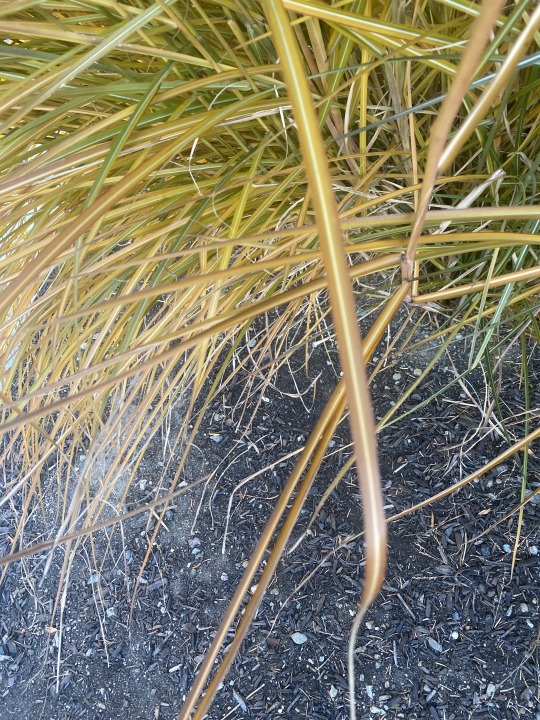

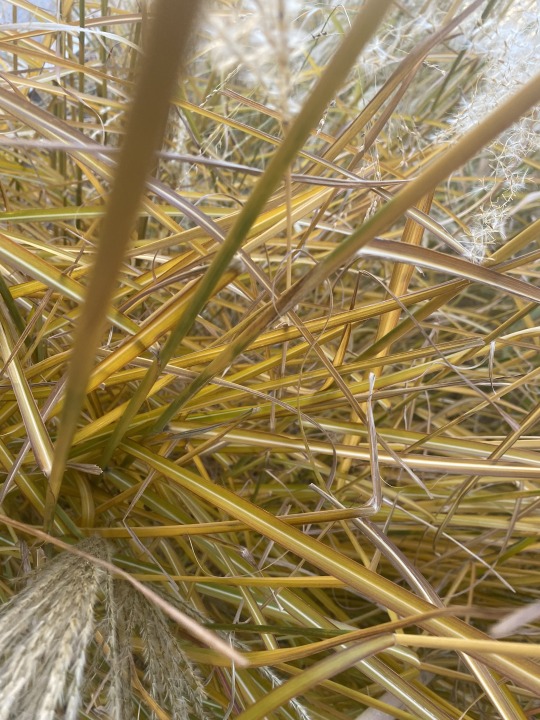
This plant was photographed at Northeastern University's arboretum near Gainsborough garage. The leaves on this plant is turning yellow yet the flowers are still apparent.
Basic Facts
This grass is native to Eastern Asia and has a cold hardiness zone of 4 to 9. The height of a mature plant can range from 4 to 9 feet with a spread of 3 to 6 feet. The grass prefers full sun to part shade as well as medium water and can tolerate a wide range of soil types. The plant is also tolerant of summer heat which makes it very tolerant in urban settings that face very hot summers. However, this plant has been classified as invasive in some parts of the United States
Design
This grass has a bloom time later than many other plants, happening in the months of June to February. The flowers on these plants have a cloud like look to them when they are clumped together. Because this is a tall grass, you should choose other plants in the shrub layer that compliment the white flowers in the blooming season. Keep in mind that when planted, the grass can grow invasively in the landscape and even spread outside of the intended area. Consider using in borders, meadows or wild gardens!
Bird attraction
Being an ornamental grass, Miscanthus sinensis does well at attracting birds. Specifically for this species, it can owe its bird attraction to the wide seed heads. These plants are especially good at attracting songbirds.
https://www.missouribotanicalgarden.org/PlantFinder/PlantFinderDetails.aspx?taxonid=285333
https://travis-tx.tamu.edu/about-2/horticulture/ornamental-plants/best-ornamental-grasses-for-birds/
https://en.wikipedia.org/wiki/Songbird
0 notes
Text
Northeast Ancondria, Present-Day: Overview

Geography
Most of the land of Northeastern Ancondria is a flat grassland about 3000 feet above sea level. Consisting of the plant species Ancondrian Crass, this region is considered the largest source of oxygen on the planet.
There are a few exceptions to the flat plains in the region, however. First is the region of Silba and Beaustrough, which consists of mountains reaching up to 7500 feet. Then there is the region surrounding the Havenlands, known as the Rim Mountains, which reach about 5000 feet. The Havenlands region itself consists of a gentle and gradual downward slope toward the sea, outlining the Southeastern half of an ancient crater. And then the land lining the coast all around the Peninsula is about 20 to 400 feet above sea level.
The climate throughout the flat grassland region is temperate, which is surprising since the region is very close to the equator; however, its high elevation means temperatures here are cooler while the air is less humid. The weather is warm and tropical year-round in the coastal regions, while cool summers and cold, snowy winters dominate the higher land near Silba and the Rim Mountains.
The United Confederation of Ancondria (UCA)
Standing as the larger of the two nations in Northeast Ancondria, the United Confederation of Ancondria, or the UCA, is governed as a direct-representative democracy, meaning that every leadership position in the executive and judicial branches, and every representative in legislature, is elected directly by the voting population.
The UCA is divided into 17 Territories. Each Territory elects 100 Delegates every year, a Governor on every second and seventh year of a given decade, and a Representative to the capital city of Providence on every third and eighth year of a given decade. On every fifth year of a decade, the UCA will elect a Governor-General serving as the Head of National Government, a post subject to a retention vote every tenth year of the decade. Every decision made by leadership is subject to override by popular referendum carried out by the population, who enjoys extensive powers of petition. Every year on a rotating basis, the UCA population will elect 11 Judges to the Supreme Court to each serve one eleven-year term.
The UCA boasts a strong military but strictly adheres to a policy of homeland defense, meaning that they do not deploy abroad unless there is a direct and imminent threat to the Confederation, a policy further enforced by the fact that the Confederation does not hold overseas territory. Most military weapons, planes, and supplies for the UCA Armed Forces are purchased from the neighboring State of Minlon.
As of the year 1475, the UCA stands as one of the most prosperous nations in Ancondria, with its primary industry being lightfire. In fact, the UCA is the world's leading producer of lightfire-made goods. The National Capital, each Territorial Capital, and its immediate lesser towns are connected with roads lined with bike paths. However, bicycles traverse these roadways more frequently than cars; and no national highway system exists because gyroplanes serve as the most common mode of transit. With the lightfire economy comes a wide variety of trades. However, all trades and industries in the UCA pursue one common agenda: environmental cleanliness. The aforementioned roadways over the grasslands are raised above the ground to help protect wildlife and, most importantly, Ancondrian Grass. Gyroplane landing pads are also raised above the ground, while the gyroplanes themselves, while they consume a minimal amount of fuel, are being constantly re-engineered to have a lesser and lesser impact on the environment.
It is also important to note that the population, itself, consists of a great number of differing nationalities. Of these nationalities include Native Ancondrians, Combrian-Ancondrians (or Comans for short), those of close kin to House Maderon, Ostar-Nabukans, Eastern Canticulans, and many folk from the nomadic maritime guilds.
The Sovereign State of Minlon
In contrast to the Ancondrian Confederation, the Sovereign State of Minlon stands as a Consular Republic. Its Head of Government consists of two Consuls presided over by a Head Consul. The Head Consul is the Commander-in-Chief of all domestic and foreign affairs, particularly when it comes to the military. The other two Consuls may give executive orders in the absence of the Head Consul, but the Head Consul can override these orders when there is either a disagreement between the other two Consuls or the Head Consul determines that the executive order agreed upon by the two Consuls is not appropriate. All three Consul positions are elected each for a six-year term but are staggered two years apart from each other, meaning that one Consul position is elected on a rotating basis every two years. Each Consul may be re-elected for an indefinite number of terms, but it is the oldest Consul in age who is deemed the Head Consul.
The Sovereign State of Minlon is divided into five Cantons, with each Canton divided into five Boroughs. Each Borough elects four Delegates, each to serve a four-year term; however, these occur on a yearly rotating basis so that one Delegate position is elected or re-elected each year. The four Delegates from each Borough meet on a regular basis in the Capital City Legislature, which is unicameral.
The Sovereign State of Minlon has one of the most expansive militaries in the world, with a division of ground army, air force, marine, and naval forces for each Canton and each Borough. This military is headed by five Chief-Generals, one for each Canton. Even though the Sovereign State of Minlon has yet to fight in a large-scale war, standing law here imposes conscription upon all young, able-bodied men between the ages of 18 to 23 years.
The de facto most powerful government institution, however, for the Sovereign State of Minlon, is the Judiciary Committee. This Committee is headed by five Arbitrators, consisting of four Arbitrators headed by one Head Arbitrator. Each of these Arbitrators is appointed to their said position by the Head Consul with the only check against such an appointment being a unanimous vote of opposition by all 100 Delegates in Legislature, a move that has never yet happened at the time of the writing of this article. Arbitrators serve a life term until retirement. These Arbitrators are responsible for every decision for every national-level case, dispute, and electoral outcome, as well as for appointing Arbitrators to preside over every Canton and Borough.
According to many critics abroad, the Judiciary Committee of the Sovereign State of Minlon has a notorious reputation for being corrupt. By constitutional principle, the Judiciary Committee is the one responsible for counting the votes and determining the outcome of every election carried out through the State. However, Arbitrators do have a right to "discount illegitimate votes, be it whether they were duplicate votes, votes cast by persons who do not exist, or votes cast by persons who were radically coerced by external influences or threats." The Judiciary Committee is known to use liberally the latter "coercion" reason to exclude certain numbers of votes cast by those opposed to the Five Banks of Minlon, and determine leaders in favor of corporate interests. Critics argue that this means that the Sovereign State of Minlon, though a democracy on paper, is not a true democracy.
There are five large banks in Minlon who own most of the businesses in Minlon as well as fund the State's expansive military. These Five Banks have a large sway in the Legislature, Consulate, and Judiciary Committees, and have been involved in numerous scandals. Of the most notorious was the establishment of the National Debt Collection Association, an organization helping to enforce unfair deals made by the Five Large Banks with businesses abroad. Most notably, numerous branches of the National Debt Collection Association, of the NDCA, consist of armed and well-trained Naval personnel, who go out with gunships into international waters and confront the cargo ships of businesses who owe debts, attacking them to salvage their goods in the form of repayment. The Independent Commonwealth State of Retun, along with many other Circlarian nations, considers this to be piracy, and the NDCA a terrorist organization.
The economy of Minlon is the complete opposite of the UCA in terms of protecting the environment, and consists of two primary industries: junk-flipping and the military. Junk-flipping involves numerous businesses purchasing goods, vessels, and supplies determined by other businesses to be of no value; junk-flippers will pay very little money for these goods and refine them to a higher quality, selling them at a much higher price. In some cases, the goods gained in the first place were not purchased but were seized by force by the NDCA during debt collector raids. Meanwhile, the military industrial complex is one of the largest in the world, with Minlon being a leader in the export of military planes, weapons, and supplies, and being neutral to warring factions, sometimes selling products to both sides of a particular conflict.
One thing to note about the economy of Minlon, however, is its staggering inequality. The City of Minlon is not just economically, but physically stratified, with high-rise skyscrapers over many square miles being connected with walkways, grass fields, parks, pools, baths, and beautiful courtyards on its top level. Those frequenting these areas consist mostly of bankers and leaders, who also own vast houses, estates, and properties out in rural areas throughout the Boroughs and Cantons. However, the nice and modern cityscape of Minlon is all on raised surfaces forty to one-hundred feet above the actual ground, while the properties in rural areas are in secluded areas and fenced in. This whole system is known to the outside world as the Silver Crust, because the remaining population lives either under the raised concrete surfaces of Minlon and the numerous shantytowns of the rural Cantons and Boroughs. Life in these parts is less than ideal, with high costs of living, low paying jobs, little opportunity for education and growth, and limited freedom of movement.
Numerous sectors of the population have pushed for change but were met with stiff oppression, especially at the hands of the Judiciary Committee and their expanded ability to overturn electoral results.
3 notes
·
View notes
Text
Creating a Buzz: Bee-Friendly Lawn Care for Northeastern Gardens #SaveYourGreen
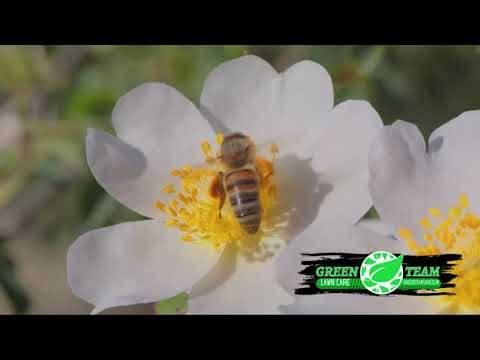
Welcome to Green Team Lawn Care, your trusted partner for eco-conscious lawn maintenance! In this blog post, we'll delve into the fascinating world of bees, specifically those found in the Northeastern United States, and explore their foraging habits and the crucial role they play as pollinators. We'll also provide you with valuable insights on how to make your lawn more bee-friendly by employing environmentally conscious practices. https://www.youtube.com/watch?v=l61lhz03tfA Bees in the Northeastern United States The Northeastern United States is home to a diverse array of bee species. These industrious insects are essential pollinators, playing a significant role in the ecosystem. Some of the most common bee species in the Northeast include honeybees, bumblebees, mason bees, and sweat bees. These bees forage for nectar and pollen to feed themselves and their offspring. By doing so, they assist in the pollination of many native plants, which, in turn, supports local wildlife and agriculture. The Importance of Bees as Pollinators Bees are the unsung heroes of our ecosystem, with a substantial impact on our daily lives. They are responsible for pollinating a wide variety of plants, including fruits, vegetables, and flowers. In fact, over 75% of global food crops depend on pollinators like bees. Without their diligent work, we would not only face a significant decline in agricultural productivity but also a substantial reduction in biodiversity. Foraging Habits of Bees Understanding the foraging habits of bees is crucial for creating a bee-friendly environment. Different bee species have unique preferences, but there are some general guidelines to follow: - Plant Diversity: Bees thrive in areas with a diverse range of flowering plants. Incorporate native wildflowers, shrubs, and trees in your garden to attract a wide variety of bees. - Continuous Blooms: Choose plants that bloom at different times of the year. This provides bees with a consistent food source throughout the growing season. - Avoid Pesticides: Pesticides, herbicides, and chemical fertilizers can harm bees. Opt for natural, organic alternatives for a bee-safe lawn care approach. Instagram Posts #SaveYourGreen https://www.instagram.com/greenteamlawnct/ Creating a Pollinator-Friendly Lawn Now that we understand the significance of bees and their foraging habits, let's explore how you can make your lawn more pollinator-friendly. 1. Choose Native Plants Native plants are adapted to the local environment and are a valuable source of nectar and pollen for bees. Incorporate a variety of native wildflowers, shrubs, and trees into your lawn to provide a continuous supply of food. 2. Reduce Lawn Area Consider reducing the size of your lawn to create more space for diverse plantings. Lawns, while attractive, offer limited resources for pollinators. Planting more flowers and bushes can help bees thrive. 3. Avoid Chemicals Bees are highly sensitive to chemical pesticides and herbicides. Opt for natural alternatives, like neem oil and beneficial insects, to manage pests in your garden. This promotes bee safety and the overall health of your lawn. 4. Create Bee Habitats Provide nesting sites for bees by installing bee hotels or leaving bare patches of ground for ground-nesting species. This simple step can make a significant difference in your garden's bee population. 5. Continuous Bloom Plant flowers that bloom at different times of the year, ensuring that bees have a consistent food source from spring through fall. This supports a thriving bee population. 6. Promote Water Sources Bees need water, too! Provide a shallow water source in your garden, such as a birdbath or a small pond, to help them stay hydrated. Conclusion Incorporating pollinator-friendly lawn care practices into your Northeastern garden not only benefits the bee populations but also contributes to a healthier and more vibrant ecosystem. By choosing native plants, reducing chemical usage, and creating bee habitats, you are taking meaningful steps toward a more sustainable and bee-safe lawn care approach. Green Team Lawn Care is here to assist you in your journey to create a bee-friendly lawn and contribute to a thriving pollinator population. Contact us today for expert advice and assistance with lawn care near you. Together, we can make a difference in preserving our precious pollinators and the environment. Read the full article
0 notes